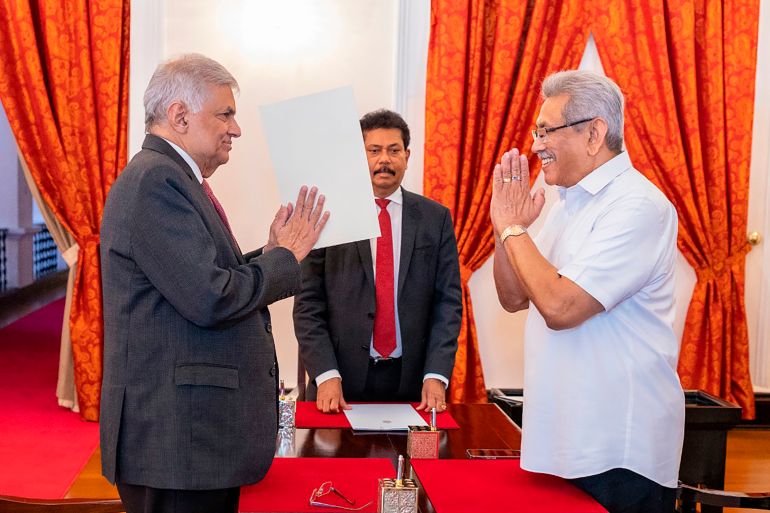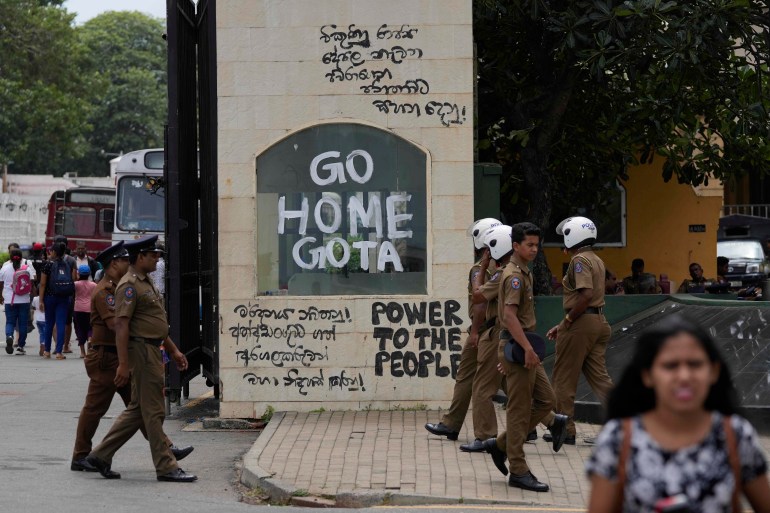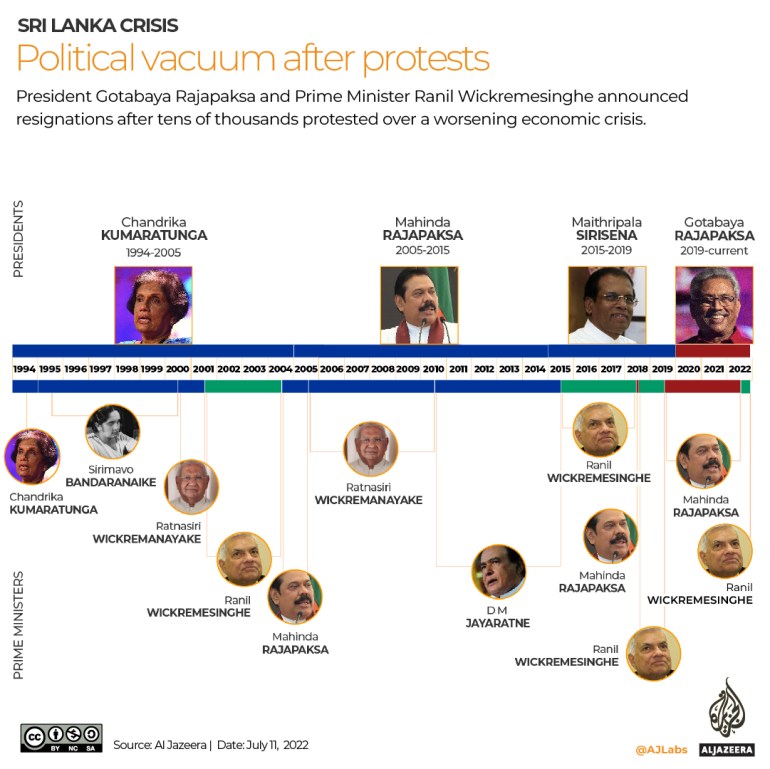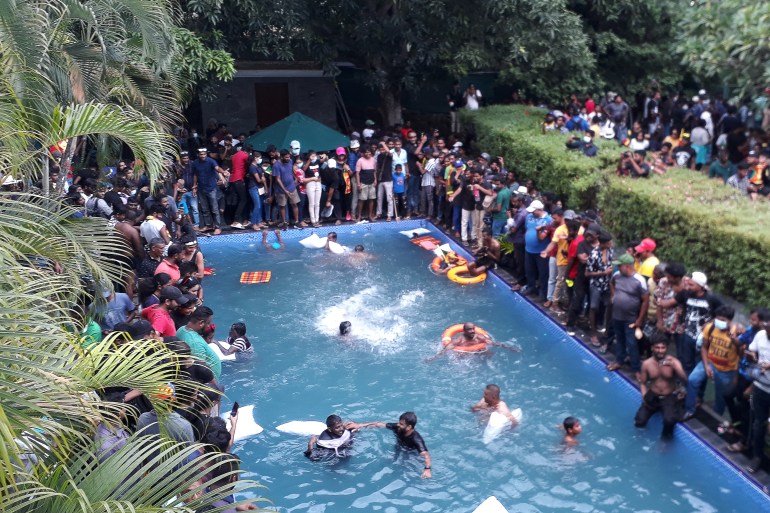Sri Lanka PM’s office confirms president to resign ‘as announced’
Protesters say they will continue to occupy government buildings till the president and the PM quit as party leaders discuss the formation of an interim government.

Sri Lanka’s President Gotabaya Rajapaksa has informed Prime Minister Ranil Wickremesinghe that he will resign “as previously announced”, the prime minister’s office has said, after tens of thousands of protesters stormed the official residences of both the leaders.
After Saturday’s sweeping protests in the wake of a debilitating economic crisis, the speaker of parliament said Rajapaksa would resign on Wednesday. However, there has been no direct word from Rajapaksa on his plans.
Keep reading
list of 4 itemsSri Lanka protesters staying put until president, PM leave office
Sri Lanka hopes to install new gov’t after day of chaos and rage
Photos: All that happened in Sri Lanka on big day of protests
Wickremesinghe has said he would also step down to allow an all-party interim government to take over.
Party leaders have been in discussion to form an alternative government, an urgent requirement of the bankrupt nation to continue discussions with the International Monetary Fund (IMF) for a bailout programme.
Wickremesinghe held a discussion with the cabinet ministers on Monday morning, the prime minister’s office said in a statement.
“All the ministers who participated in the discussion were of the opinion that as soon as there is an agreement to form an all-party government, they are ready to hand over their responsibilities to that government,” it said.

Legislator Udaya Gammanpila said the main opposition United People’s Front and politicians who defected Rajapaksa’s ruling coalition have also had discussions and agreed to work together.
Main opposition leader Sajith Premadasa and Dullas Alahapperuma, who was a minister under Rajapaksa, have been proposed for president and prime minister, respectively, The Associated Press news agency reported.
Premadasa and Alahapperuma have been requested to decide on how to share the positions before a meeting with the parliament speaker later on Monday, the AP said.
“We can’t be in an anarchical condition. We have to somehow reach a consensus today,” Gammanpila said on Monday.
Constitutional experts say once the president and the prime minister formally resign, the next step would be for the speaker to be appointed as acting president and for parliament to vote for a new president within 30 days to complete Rajapaksa’s term that was to end in 2024.

‘We’re not going anywhere’
Meanwhile, leaders of the protest movement in the country of 22 million say they will continue to occupy the residences of the president and the prime minister in capital Colombo until they finally quit office.
“There are thousands of people who keep streaming in to have a look at the property. They are being sent in batches because you just can’t handle the sheer numbers,” Al Jazeera’s Minelle Fernandez reported on Monday from outside the President’s House in Colombo.
Saturday was the biggest and most eventful day of protests over the past three months when mass protests over the economic crisis started.
Months of demonstrations have all but dismantled the Rajapaksa political dynasty, which has ruled Sri Lanka for most of the past two decades but is accused by protesters of mismanagement and corruption.
“He is no longer the president of Sri Lanka, he has been expelled by the citizens of Sri Lanka. Therefore, it is a victorious moment,” actress Visaka Jayamene told Al Jazeera.
Colombo was calm on Monday as hundreds of people strolled into the president’s secretariat and residence and toured the colonial-era buildings. Police made no attempt to stop anyone.
“We are not going anywhere till this president leaves and we have a government that is acceptable to the people,” said Jude Hansana, 31, who has been at a protest site outside the residence since early April.
“The people’s struggle is for wider political reforms. Not just for the president to leave. This is just the start.”
Another protester, Dushantha Gunasinghe, said he had travelled to Colombo from a town 130km (80 miles) away, walking part of the way because of the fuel crunch. He said he finally reached on Monday morning.
“I’m so exhausted, I can barely speak,” said the 28-year-old as he sat on a plastic chair outside the president’s office. “I came alone all this way because I believe we need to see this through. This government needs to go home and we need better leaders.”

Rajapaksa and Wickremesinghe were not in their residences when the protesters surged into the buildings and have not been seen in public since Friday. Their whereabouts are unknown.
Wickremesinghe’s private home in an affluent Colombo suburb was set on fire, and three suspects have been arrested, police said.
“This is going to be an extremely critical time to ensure there is political stability as well as economic stability at a time where there is also a law and order situation erupting,” Bhavani Fonseka of the Centre for Policy Alternatives told Al Jazeera.
Sri Lanka announced in April that it was suspending repayment of foreign loans due to a foreign currency shortage. Its total foreign debt amounts to $51bn, of which it must repay $28bn by the end of 2027.
Common Sri Lankans have mainly blamed Rajapaksa for the collapse of the tourism-dependent economy, which was hammered badly by the COVID-19 pandemic and a ban on chemical fertilisers that was later reversed.
Government finances were crippled by mounting debt and lavish tax breaks given by the Rajapaksa government.
The country barely has any dollars left to import fuel, which has been severely rationed, and long lines have formed in front of shops selling cooking gas.
Headline inflation in Sri Lanka hit 54.6 percent last month, and the central bank has warned that it could rise to 70 percent in the coming months as the country is relying on aid from India and other nations.